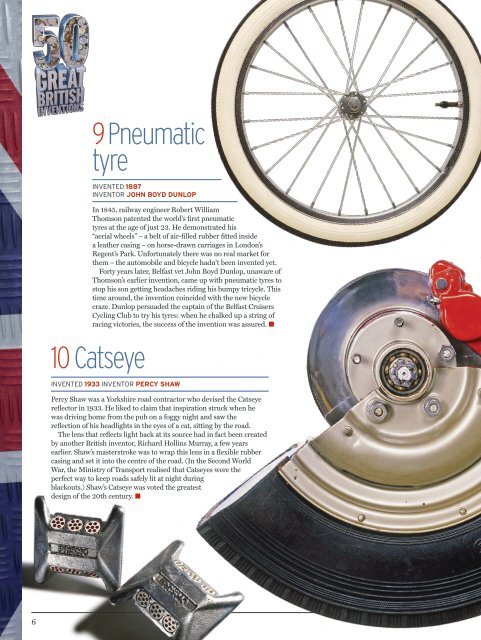50 Great British Inventions - BBC
50 Great British Inventions - BBC
50 Great British Inventions - BBC
Create successful ePaper yourself
Turn your PDF publications into a flip-book with our unique Google optimized e-Paper software.
9 Pneumatic<br />
tyre<br />
Invented 1887<br />
Inventor John boyd dunlop<br />
In 1845, railway engineer Robert William<br />
Thomson patented the world’s first pneumatic<br />
tyres at the age of just 23. He demonstrated his<br />
“aerial wheels” – a belt of air-filled rubber fitted inside<br />
a leather casing – on horse-drawn carriages in London’s<br />
Regent’s Park. Unfortunately there was no real market for<br />
them – the automobile and bicycle hadn’t been invented yet.<br />
Forty years later, Belfast vet John Boyd Dunlop, unaware of<br />
Thomson’s earlier invention, came up with pneumatic tyres to<br />
stop his son getting headaches riding his bumpy tricycle. This<br />
time around, the invention coincided with the new bicycle<br />
craze. Dunlop persuaded the captain of the Belfast Cruisers<br />
Cycling Club to try his tyres: when he chalked up a string of<br />
racing victories, the success of the invention was assured. <br />
10 Catseye<br />
Invented 1933 Inventor pERcy shaw<br />
Percy Shaw was a Yorkshire road contractor who devised the Catseye<br />
reflector in 1933. He liked to claim that inspiration struck when he<br />
was driving home from the pub on a foggy night and saw the<br />
reflection of his headlights in the eyes of a cat, sitting by the road.<br />
The lens that reflects light back at its source had in fact been created<br />
by another <strong>British</strong> inventor, Richard Hollins Murray, a few years<br />
earlier. Shaw’s masterstroke was to wrap this lens in a flexible rubber<br />
casing and set it into the centre of the road. (In the Second World<br />
War, the Ministry of Transport realised that Catseyes were the<br />
perfect way to keep roads safely lit at night during<br />
blackouts.) Shaw’s Catseye was voted the greatest<br />
design of the 20th century. <br />
11 Carbon fibre<br />
Invented 1963<br />
Inventors Royal aiRcRaft EstablishmEnt EnginEERs<br />
This marvellous material is one of many inventions developed by the<br />
military that are incredibly useful for us all. In 1963, engineers at the<br />
Royal Aircraft Establishment’s research station at Farnborough worked<br />
out how to reinforce plastics with carbon filaments to produce a material<br />
that was strong, lightweight and could be mass-produced.<br />
Early on, there were setbacks – carbon fibre was used for the turbine<br />
blades for the Rolls-Royce RB-211 jet engine, but the lightweight blades<br />
just weren’t strong enough. They failed the bird-strike test – they<br />
shattered when a frozen chicken was fired into them at high<br />
speed – and the engine had to be scrapped at huge cost.<br />
But the inventors at Farnborough found other<br />
uses for the material and today the material<br />
has thousands of applications in<br />
boats, cars, motorbikes,<br />
sports equipment, and<br />
even in the fuselages<br />
of jumbo jets. <br />
6 RadioTimes <strong>50</strong> <strong>Great</strong> <strong>British</strong> <strong>Inventions</strong><br />
DID YOU KNOW?<br />
the rae team<br />
improved upon<br />
experiments<br />
with carbon<br />
fibre<br />
previously<br />
conducted by<br />
american and<br />
japanese<br />
researchers.<br />
12 Disc<br />
brakes<br />
Invented 1902 Inventor<br />
fREdERick william<br />
lanchEstER<br />
Frederick William Lanchester<br />
was one of Britain’s first<br />
motorcar designers and<br />
manufacturers. Disc brakes<br />
employ brake pads that squeeze<br />
each side of the rotor turning a<br />
wheel, and they were fitted to the cars<br />
made by his Lanchester Engine<br />
Company in Birmingham. They were<br />
quicker to cool down and to dry out than<br />
the drum brakes used in most cars at the time.<br />
Sadly, Lanchester lacked the money and<br />
business acumen to develop them properly.<br />
He made his brakes using copper, which wore<br />
down too quickly, and they didn’t catch on.<br />
It was only in the 19<strong>50</strong>s, after Lanchester had<br />
died, that car makers decided to use stronger<br />
and more durable materials, like cast iron.<br />
Today, almost all cars use his invention. <br />
michaEl moslEy<br />
13 Steam engine<br />
Invented 1801<br />
Inventor RichaRd tREvithick<br />
the high-pressure steam engine<br />
is the most extraordinary invention<br />
of all time. It made the Industrial<br />
revolution possible; it made the<br />
modern world possible.<br />
For most of history, empires ran<br />
on one thing: slave power. during<br />
richard trevithick’s time we had wind power and<br />
water power to a very limited extent, but it wasn’t<br />
portable: you had to build your generator next to a<br />
stream if you wanted to tap into it. What trevithick<br />
did with high-pressure steam was to take power, in<br />
this case in the form of coal, and turn it into<br />
workable energy.<br />
everybody believes that James Watt was<br />
responsible for the modern engine, but he wasn’t.<br />
What he did was improve on another invention<br />
called the atmospheric engine (devised by thomas<br />
newcomen in 1712). It was the size of a house,<br />
could never have been portable and operated<br />
on a completely different principle to the modern<br />
steam engine. It could pump water, but basically<br />
it was dead-end technology.<br />
trevithick’s invention, however, would become<br />
the father of the steam train and the father of<br />
portable steam power. on Christmas eve 1801 he<br />
tested a steam car, known as the Puffing Devil, which<br />
successfully climbed Camborne Hill in Cornwall.<br />
In doing so, trevithick became the first person<br />
to power a piston using high-pressure steam. It had<br />
been attempted for 2,000 years, but every time<br />
people had tried, it had blown up and usually killed<br />
whoever was nearby. trevithick managed it: he<br />
had the materials and the know-how, and his<br />
invention reduced the steam engine from the size<br />
of a house to the size of a modern car. He liberated<br />
power, and in doing so transformed the world. <br />
Michael Mosley’s four-part series, The Genius<br />
of Invention, begins next week on <strong>BBC</strong>2<br />
7

















